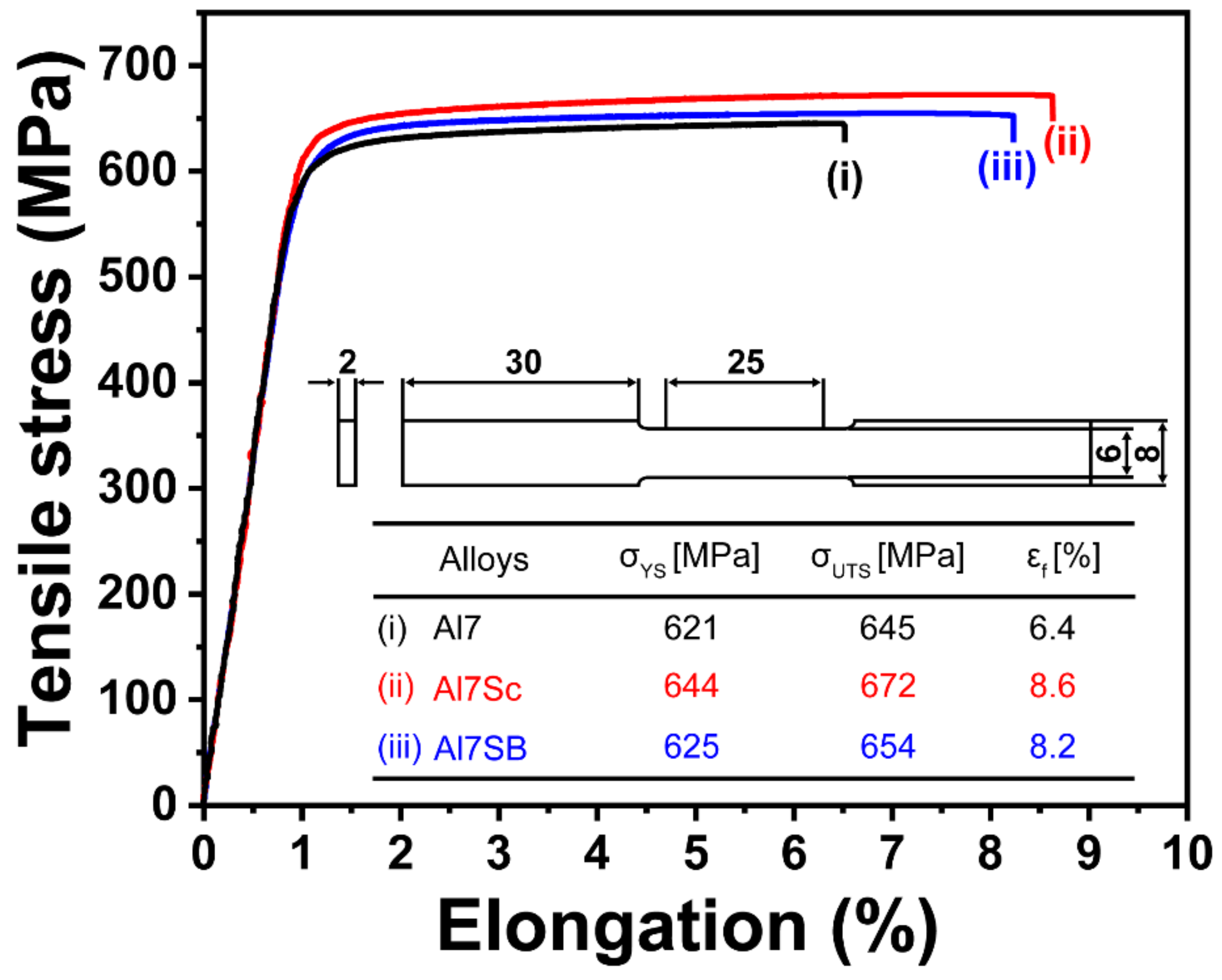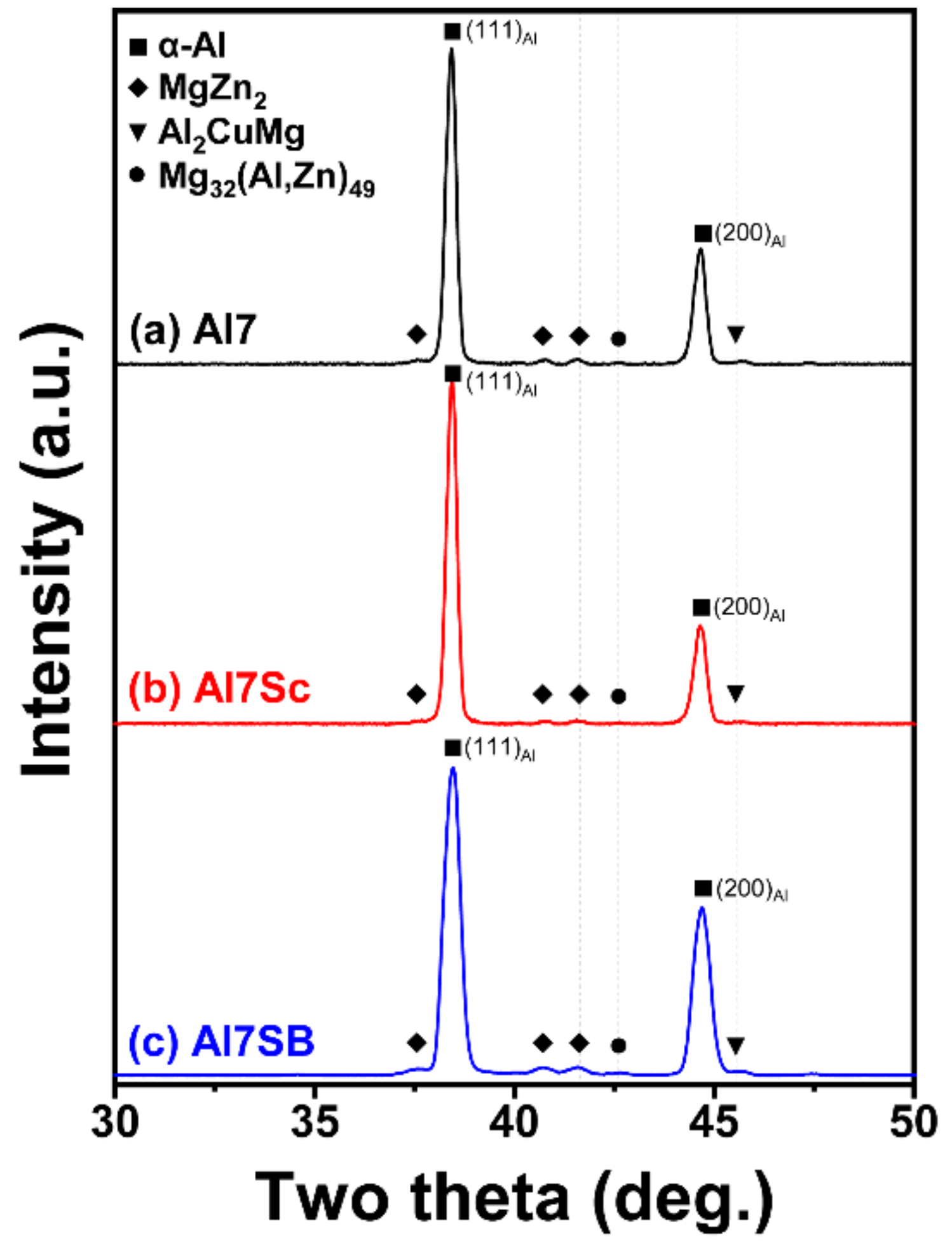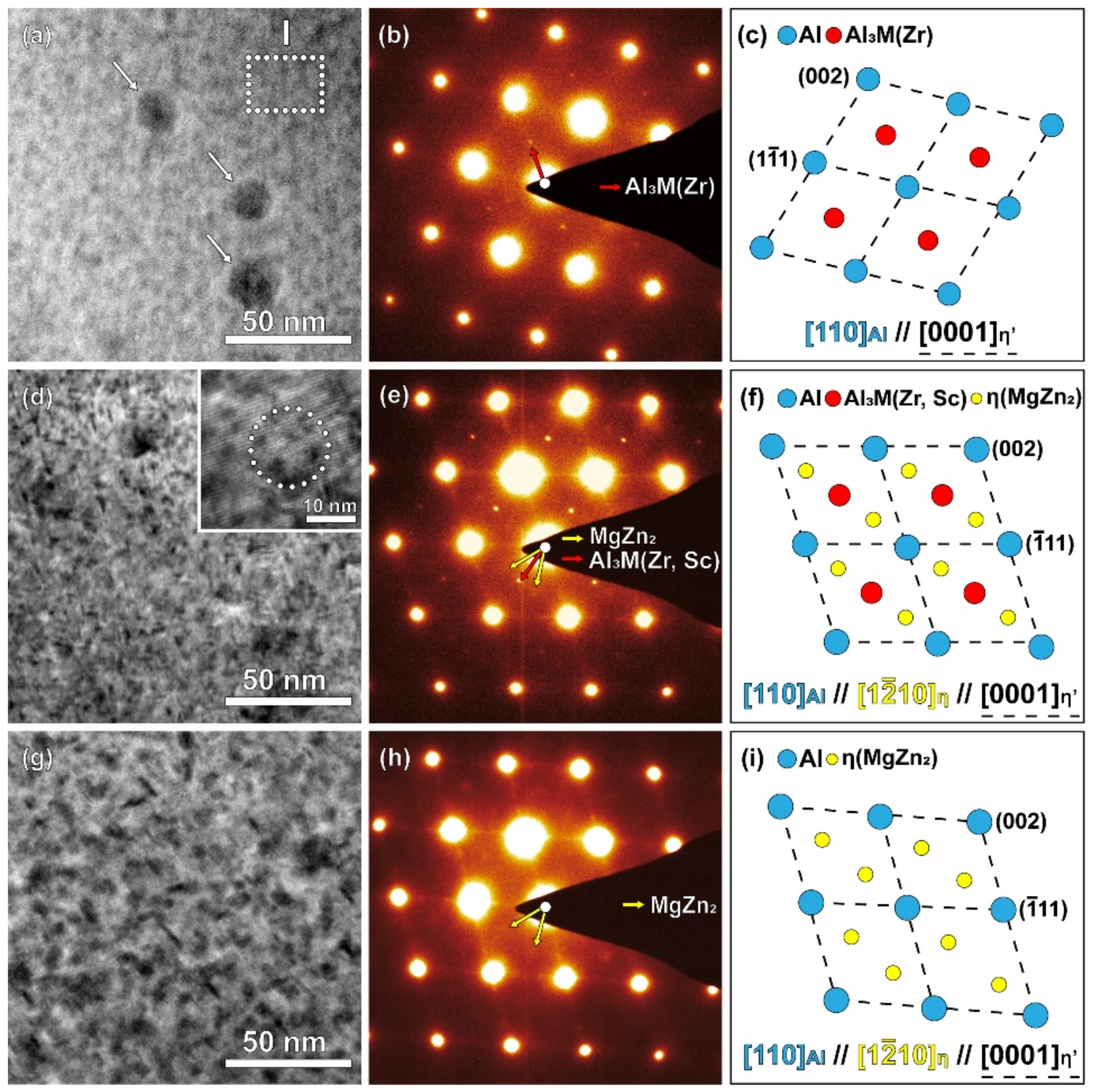Effects of Sc and Be Microalloying Elements on Mechanical Properties of Al-Zn-Mg-Cu (Al7xxx) Alloy
Abstract
1. Introduction
2. Experimental Procedures
3. Results
4. Discussion
5. Conclusions
- (1)
- Sc microalloying effect
- (2)
- Be microalloying effect
Author Contributions
Funding
Institutional Review Board Statement
Informed Consent Statement
Data Availability Statement
Conflicts of Interest
References
- Wei, S.; Wang, R.; Zhang, H.; Xu, C.; Wu, Y.; Feng, Y. Influence of Cu/Mg ratio on microstructure and mechanical properties of Al–Zn–Mg–Cu alloys. J. Mater. Sci. 2021, 56, 3472–3487. [Google Scholar] [CrossRef]
- Chen, Z.; Zheng, Z. Microstructural evolution and ageing behaviour of the low Cu: Mg ratio Al–Cu–Mg alloys containing scandium and lithium. Scr. Mater. 2004, 50, 1067–1071. [Google Scholar] [CrossRef]
- Zuo, J.; Hou, L.; Shu, X.; Peng, W.; Yin, A.; Zhang, J. Grain refinement assisted by deformation enhanced precipitates through thermomechanical treatment of AA7055 Al alloy. Metals 2020, 10, 594. [Google Scholar] [CrossRef]
- Mandal, P.K.; Robi, P.S. Influence of micro-alloying with silver on microstructure and mechanical properties of Al-Cu alloy. Mater. Sci. Eng. A 2018, 722, 99–111. [Google Scholar] [CrossRef]
- Li, B.; Pan, Q.; Huang, X.; Yin, Z. Microstructures and properties of Al–Zn–Mg–Mn alloy with trace amounts of Sc and Zr. Mater. Sci. Eng. A 2014, 616, 219–228. [Google Scholar] [CrossRef]
- Huang, Y.; Zhang, C.; Ma, Y.; Liu, Y. Effects of homogenization on the dissolution and precipitation behaviors of intermetallic phase for a Zr and Er containing Al–Zn–Mg–Cu alloy. Prog. Nat. Sci. 2020, 30, 47–53. [Google Scholar] [CrossRef]
- Freiberg, D.; Zhu, W.; Park, J.-S.; Almer, J.D.; Sanders, P. Precipitate characterization in model Al-Zn-Mg-(Cu) alloys using small-angle X-ray scattering. Metals 2020, 10, 959. [Google Scholar] [CrossRef]
- Zhong, H.; Li, S.; Zhang, Z.; Li, D.; Deng, H.; Chen, J.; Qi, L.; Ojo, O.A. Precipitation behavior, mechanical properties, and corrosion resistance of rare earth–modified Al-Zn-Mg-Cu alloys. Mater. Today Commun. 2022, 31, 103732. [Google Scholar] [CrossRef]
- Robson, J.; Prangnell, P.B. Dispersoid precipitation and process modelling in zirconium containing commercial aluminium alloys. Acta Metall. 2001, 49, 599–613. [Google Scholar] [CrossRef]
- Nes, E. Precipitation of the metastable cubic Al3Zr-phase in subperitectic Al-Zr alloys. Acta Metall. 1972, 20, 499–506. [Google Scholar] [CrossRef]
- Zhou, B.; Liu, B.; Zhang, S. The advancement of 7xxx series aluminum alloys for aircraft structures: A review. Metals 2021, 11, 718. [Google Scholar] [CrossRef]
- Zuo, J.; Hou, L.; Shi, J.; Cui, H.; Zhuang, L.; Zhang, J. The mechanism of grain refinement and plasticity enhancement by an improved thermomechanical treatment of 7055 Al alloy. Mater. Sci. Eng. A 2017, 702, 42–52. [Google Scholar] [CrossRef]
- Sun, Y.; Luo, Y.; Pan, Q.; Liu, B.; Long, L.; Wang, W.; Ye, J.; Huang, Z.; Xiang, S. Effect of Sc content on microstructure and properties of Al-Zn-Mg-Cu-Zr alloy. Mater. Today Commun. 2021, 26, 101899. [Google Scholar] [CrossRef]
- Vo, N.Q.; Dunand, D.C.; Seidman, D.N. Improving aging and creep resistance in a dilute Al–Sc alloy by microalloying with Si, Zr and Er. Acta Mater. 2014, 63, 73–85. [Google Scholar] [CrossRef]
- Guan, R.; Shen, Y.; Zhao, Z.; Wang, X. A high-strength, ductile Al-035.Sc-0.2 Zr alloy with good electrical conductivity strengthened by coherent nanosized-precipitates. J. Mater. Sci. Technol. 2017, 33, 215–223. [Google Scholar]
- Liu, F.C.; Ma, Z.Y.; Zhang, F.C. High strain rate superplasticity in a micro-grained Al–Mg–Sc alloy with predominant high angle grain boundaries. J. Mater. Sci. Technol. 2012, 28, 1025–1030. [Google Scholar] [CrossRef]
- Hyland, R.W. Homogeneous nucleation kinetics of Al3Sc in a dilute Al-Sc alloy. Metall. Trans. A 1992, 23, 1947–1955. [Google Scholar] [CrossRef]
- Clouet, E.; Barbu, A.; Laé, L.; Martin, G. Precipitation kinetics of Al3Zr and Al3Sc in aluminum alloys modeled with cluster dynamics. Acta Mater. 2005, 53, 2313–2325. [Google Scholar] [CrossRef]
- Riva, S.; Yusenko, K.V.; Lavery, N.P.; Jarvis, D.J.; Brown, S.G. The scandium effect in multicomponent alloys. Int. Mater. Rev. 2016, 61, 203–228. [Google Scholar] [CrossRef]
- Sun, F.; Nash, G.L.; Li, Q.; Liu, E.; He, C.; Shi, C.; Zhao, N. Effect of Sc and Zr additions on microstructures and corrosion behavior of Al-Cu-Mg-Sc-Zr alloys. J. Mater. Sci. Technol. 2017, 33, 1015–1022. [Google Scholar] [CrossRef]
- Chen, Y.; Gao, N.; Sha, G.; Ringer, S.P.; Starink, M.J. Microstructural evolution, strengthening and thermal stability of an ultrafine-grained Al–Cu–Mg alloy. Acta Mater. 2016, 109, 202–212. [Google Scholar] [CrossRef]
- Tsivoulas, D.; Robson, J. Heterogeneous Zr solute segregation and Al3Zr dispersoid distributions in Al–Cu–Li alloys. Acta Mater. 2015, 93, 73–86. [Google Scholar] [CrossRef]
- Zhao, H.; De Geuser, F.; da Silva, A.K.; Szczepaniak, A.; Gault, B.; Ponge, D.; Raabe, D. Segregation assisted grain boundary precipitation in a model Al-Zn-Mg-Cu alloy. Acta Mater. 2018, 156, 318–329. [Google Scholar] [CrossRef]
- Qian, Y.; Xue, J.; Wang, Z.; Yang, Z.; Qian, P. Mechanical Properties Evaluation of Zr Addition in L12-Al3(Sc1−xZrx) Using First-Principles Calculation. Jom 2016, 68, 1293–1300. [Google Scholar] [CrossRef]
- Spierings, A.B.; Dawson, K.; Heeling, T.; Uggowitzer, P.J.; Schäublin, R.; Palm, F.; Wegener, K. Microstructural features of Sc-and Zr-modified Al-Mg alloys processed by selective laser melting. Mater. Des. 2017, 115, 52–63. [Google Scholar] [CrossRef]
- Röyset, J.; Ryum, N. Scandium in aluminium alloys. Int. Mater. Rev. 2005, 50, 19–44. [Google Scholar] [CrossRef]
- Costa, S.; Puga, H.; Barbosa, J.; Pinto, A. The effect of Sc additions on the microstructure and age hardening behaviour of as cast Al–Sc alloys. Mater. Des. 2012, 42, 347–352. [Google Scholar] [CrossRef]
- Tzeng, Y.-C.; Wu, C.-T.; Yang, C.-H.; Lee, S.-L. Effects of trace Be and Sc addition on the thermal stability of Al–7Si–0.6 Mg alloys. Mater. Sci. Eng. A 2014, 614, 54–61. [Google Scholar] [CrossRef]
- Tzeng, Y.-C.; Nieh, J.-K.; Bor, H.-Y.; Lee, S.-L. Effect of trace Be and Sc additions on the mechanical properties of A357 alloys. Metals 2018, 8, 194. [Google Scholar] [CrossRef]
- Mukhopadhyay, A.K.; Singh, V.; Prasad, K.S.; Chakravorty, C.R. On S (Al2CuMg) precipitation in an AlCuMg alloy containing small additions of beryllium. Acta Mater. 1996, 44, 3115–3124. [Google Scholar] [CrossRef]
- Liu, X.; Zhang, P.; He, S.; Xu, Q.; Dou, Z.; Wang, H. Effect of beryllium content and heat treatment on microstructure and yield strength in Be/6061Al composites. J. Alloys Compd. 2018, 743, 746–755. [Google Scholar] [CrossRef]
- Ogura, T.; Hirosawa, S.; Cerezo, A.; Sato, T. Atom probe tomography of nanoscale microstructures within precipitate free zones in Al–Zn–Mg (–Ag) alloys. Acta Mater. 2010, 58, 5714–5723. [Google Scholar] [CrossRef]
- Won, S.-J.; So, H.; Kang, L.; Oh, S.J.; Kim, K.-H. Development of a high-strength Al-Zn-Mg-Cu-based alloy via multi-strengthening mechanisms. Scr. Mater. 2021, 205, 114216. [Google Scholar] [CrossRef]
- So, H.; Won, S.-J.; Park, J.; Oh, S.J.; Kang, L.; Kim, K.-H. Mechanical properties and microstructural evolution in Al–Cu–Mg–Ag alloy with a CuxMgx/10 content. Mater. Sci. Eng. A 2021, 824, 141573. [Google Scholar] [CrossRef]
- Park, M.-J.; So, H.; Kang, L.; Byeon, J.-W.; Kim, K.-H. The relation between mechanical properties and microstructural evolution induced by Sc microalloying in Al-20Zn-3Cu alloy. J. Alloys Compd. 2021, 889, 161719. [Google Scholar] [CrossRef]
- Xiao, H.; Wang, Z.; Geng, J.; Zhang, C.; Li, Y.; Yang, Q.; Wang, M.; Chen, D.; Li, Z.; Wang, H. Precipitation and crystallographic relationships of nanosized η/η’precipitates at S-Al interface in Al-Zn-Mg-Cu alloy. Scr. Mater. 2022, 214, 114643. [Google Scholar] [CrossRef]
- Zou, Y.; Wu, X.; Tang, S.; Zhu, Q.; Song, H.; Cao, L. Co-precipitation of T′ and η′ phase in Al-Zn-Mg-Cu alloys. Mater. Charact. 2020, 169, 110610. [Google Scholar] [CrossRef]
- Mondal, C.; Mukhopadhyay, A.K. On the nature of T (Al2Mg3Zn3) and S (Al2CuMg) phases present in as-cast and annealed 7055 aluminum alloy. Mater. Sci. Eng. A 2005, 391, 367–376. [Google Scholar] [CrossRef]
- Takata, N.; Ishihara, M.; Suzuki, A.; Kobashi, M. Microstructure and strength of a novel heat-resistant aluminum alloy strengthened by T-Al6Mg11Zn11 phase at elevated temperatures. Mater. Sci. Eng. A 2019, 739, 62–70. [Google Scholar] [CrossRef]
- Knipling, K.E.; Karnesky, R.A.; Lee, C.P.; Dunand, D.C.; Seidman, D.N. Precipitation evolution in Al–0.1Sc, Al–0.1Zr and Al–0.1Sc–0.1Zr (at.%) alloys during isochronal aging. Acta Mater. 2010, 58, 5184–5195. [Google Scholar] [CrossRef]
- Zhang, M.; Liu, T.; He, C.; Ding, J.; Liu, E.; Shi, C.; Li, J.; Zhao, N. Evolution of microstructure and properties of Al–Zn–Mg–Cu–Sc–Zr alloy during aging treatment. J. Alloys Compd. 2016, 658, 946–951. [Google Scholar] [CrossRef]
- Karov, J.; Youdelis, W.; Herring, R. Clustering in Al–3Cu–0.1Be. Mater. Sci. Technol. 1986, 2, 547–551. [Google Scholar] [CrossRef]
- Luo, A.; Youdelis, W.V. Microstructure and mechanical behavior of Al-Li-Cu-Mg alloy 8090 microalloyed with V and Be. Metall. Trans. A 1993, 24, 95–104. [Google Scholar] [CrossRef]
- Youdelis, W.; Fang, W.; Lowes, T. Precipitation and age hardening behaviour of AI–0.2Ti–0.2Be alloy. Mater. Sci. Technol. 1990, 6, 1227–1230. [Google Scholar] [CrossRef]
- Cao, Y.; Ni, S.; Liao, X.; Song, M.; Zhu, Y. Structural evolutions of metallic materials processed by severe plastic deformation. Mater. Sci. Eng. R Rep. 2018, 133, 1–59. [Google Scholar] [CrossRef]





| Alloys | Chemical Composition (wt.%) | ||||||
|---|---|---|---|---|---|---|---|
| Al | Zn | Mg | Cu | Sc | Be | Zr | |
| Al7 | Bal. | 9.0 | 3.0 | 3.0 | - | - | 0.08 |
| Al7Sc | Bal. | 9.0 | 3.0 | 3.0 | 0.1 | - | 0.08 |
| Al7SB | Bal. | 9.0 | 3.0 | 3.0 | 0.1 | 0.06 | 0.08 |
| Alloys | Chemical Composition (wt.%) | ||||||
|---|---|---|---|---|---|---|---|
| Al | Zn | Mg | Cu | Sc | Be | Zr | |
| Al7 | Bal. | 9.02 | 2.96 | 3.08 | - | - | 0.09 |
| Al7Sc | Bal. | 8.88 | 3.01 | 3.10 | 0.09 | - | 0.09 |
| Al7SB | Bal. | 9.06 | 2.93 | 3.06 | 0.08 | 0.04 | 0.08 |
Disclaimer/Publisher’s Note: The statements, opinions and data contained in all publications are solely those of the individual author(s) and contributor(s) and not of MDPI and/or the editor(s). MDPI and/or the editor(s) disclaim responsibility for any injury to people or property resulting from any ideas, methods, instructions or products referred to in the content. |
© 2023 by the authors. Licensee MDPI, Basel, Switzerland. This article is an open access article distributed under the terms and conditions of the Creative Commons Attribution (CC BY) license (https://creativecommons.org/licenses/by/4.0/).
Share and Cite
Won, S.-J.; So, H.; Han, J.-W.; Oh, S.J.; Kang, L.; Kim, K.-H. Effects of Sc and Be Microalloying Elements on Mechanical Properties of Al-Zn-Mg-Cu (Al7xxx) Alloy. Metals 2023, 13, 340. https://doi.org/10.3390/met13020340
Won S-J, So H, Han J-W, Oh SJ, Kang L, Kim K-H. Effects of Sc and Be Microalloying Elements on Mechanical Properties of Al-Zn-Mg-Cu (Al7xxx) Alloy. Metals. 2023; 13(2):340. https://doi.org/10.3390/met13020340
Chicago/Turabian StyleWon, Sung-Jae, Hyeongsub So, Jung-Woo Han, Soong Ju Oh, Leeseung Kang, and Kyou-Hyun Kim. 2023. "Effects of Sc and Be Microalloying Elements on Mechanical Properties of Al-Zn-Mg-Cu (Al7xxx) Alloy" Metals 13, no. 2: 340. https://doi.org/10.3390/met13020340
APA StyleWon, S.-J., So, H., Han, J.-W., Oh, S. J., Kang, L., & Kim, K.-H. (2023). Effects of Sc and Be Microalloying Elements on Mechanical Properties of Al-Zn-Mg-Cu (Al7xxx) Alloy. Metals, 13(2), 340. https://doi.org/10.3390/met13020340






